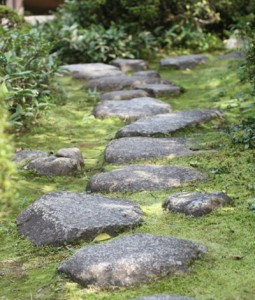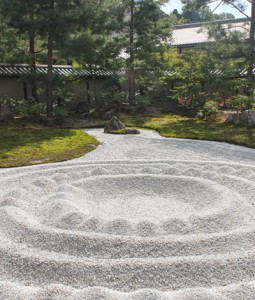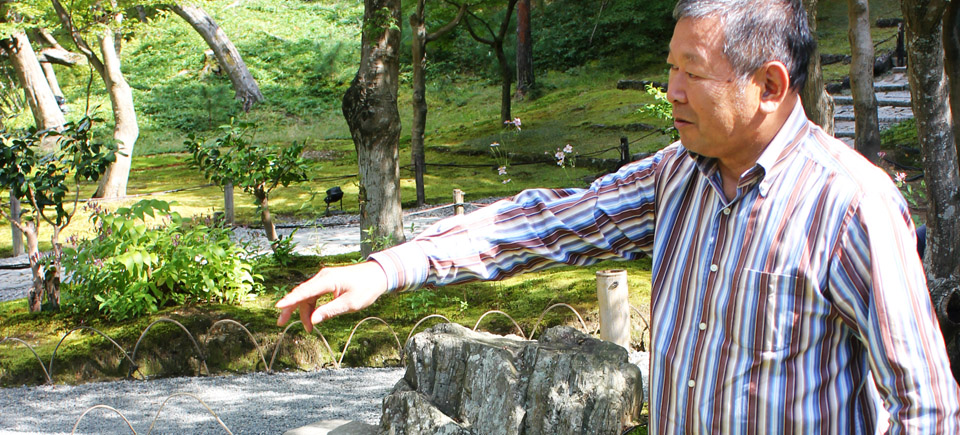Feature
The Spirit of Things
Internationally renowned landscape artist Yasuo Kitayama takes us to admire his Kyoto Zen gardens.
 Yasuo Kitayama meets me in a little teahouse on the grounds of Kodai-ji, a temple in Kyoto’s Higashiyama district. Through the open window we look out at the Tsukiyama garden – a landscape of little moss-covered hills, ancient stones and immaculate gravel paths. As I was about to learn, the beautiful scenery before us is charged with history and meaning.
Yasuo Kitayama meets me in a little teahouse on the grounds of Kodai-ji, a temple in Kyoto’s Higashiyama district. Through the open window we look out at the Tsukiyama garden – a landscape of little moss-covered hills, ancient stones and immaculate gravel paths. As I was about to learn, the beautiful scenery before us is charged with history and meaning.
“There are two ways of looking at everything,” Kitayama began. “Death and spirit, or appearance and training (shugyo – conducting oneself in a way that inspires mastery). In the winter the scenery is sad – very sad. It shows us the impermanence of all things. It’s very cold and you have to express that, while in the summertime you express green and freshness. My job is different from someone whose job is just to plant flowers.”
Polite and understated like most people of Kyoto, Kitayama is distinguished by a kind of restless energy and something of a mischievous streak. Eyes twinkling with intelligence and humor, he makes no attempt to conceal the depth of his passion. I ask him how he became a gardener, and he beams.
“That’s a great question! My story eventually brought me here. I come from a family of landscape artists. It’s a bit embarrassing but I used to play a lot of baseball. My coach wanted me to go to a school in Tottori to pursue it but I refused. Everyone disagreed, but I didn’t like having my life mapped out for me like that … It wasn’t that it was what I wanted to be (a landscape gardener), but I said I’ll just try it and if it’s no good I’ll quit,” he explained.
He describes his gardening apprenticeship as a grueling process, as challenging mentally as it was physically. Again and again he uses the word nintai, meaning to endure or persevere – a very deep word in Japanese culture.
“I forget the place, but there were these big logs. I would have been 22, and my job was just to clean these logs. All day long. And it was those kinds of tasks for the first three years, you know, tidy up this ridgeline like this, stand this stone up like this, work on the edge of this hedge or slope … but that’s how it is.
“When sempai says this is black, it’s black. Even when it’s white … The hardest thing at that time was finding the self-belief. You understand they don’t teach you anything – you have to see it for yourself. Everything is nintai. You just keep trying until it’s perfect – there is no ‘that’s enough.’ It’s a hundred, or zero.”
Kitayama gave it his all and became an accomplished landscape artist, having designed gardens all over the world including the Giardino delle rose at the Piazzale Michelangelo in Florence, Italy. He started his own business at 26 years old, and has landscaped the Chouon Tei at Kennin-ji, the oldest Zen temple in Kyoto. He is in charge of all the gardens at Kodai-ji, including Entokuin. Up to 2000 people will work on the grounds in one year.
Kitayama is no less rigorous in continuing the nintai tradition with his own students, known as deshi. “The work is very hard – more than full time – I’m very strict with my deshi. They work from 6:30 in the morning until 8:00 at night. You can’t call it overtime, it’s just what you have to do if you want to learn. Preparing for tomorrow, reviewing what you learned today. If you want to be better, you have to practice more than everyone else. That’s very important.
“It’s a bad thing to say, but most people, even if they make a lot of effort, have a limit that they cannot go beyond. It’s not about distinction or discrimination, it’s just the way of things. I always try to encourage the young guys but the truth is most will never become great. It’s depressing, isn’t it! It’s my hope for everyone to succeed, but…”
Discussing form and arrangement, Kitayama describes a complicated geometric system drawn from centuries-old texts like sakuteiki and primarily concerned with the placement and alignment of stones on intersecting lines.
“What they tell us is that you can’t beat natural forms – if you understand this you can be a true gardener. There are rules, but beyond that there is something uncertain – in Japanese we say aimai (it’s ambiguous) – and it’s different depending on the place.” The forms of trees and plants meanwhile are governed by the same rules of spatial arrangement found in ikebana (Japanese flower arrangement).
Kitayama takes me to see the Hashin Tei – a karesansui or rock garden that he himself created, with mossy islands bordering a sea of raked gravel, raised at the center around a circle of cones and domes. He brings me to the front, where we sit on the veranda of the old abbot’s residence. It is from this precise angle, he tells me, that he made it to be seen. Another stunning view – but what does it mean?
“The big rock is the Shaka (Buddha). The smaller ones surrounding him are his deshi (apprentices). The uzumaki (spiral patterns in the gravel) have to do with the mind lighting up,” explains Kitayama.
He says appreciating a Japanese rock garden is not necessarily about having to know things, but about being able to connect with the garden in your own way and experience it through your own feelings.
“Kokoro – heart, mind, emotions. It’s not about knowing things … Look at it from yourself and feel it directly, that’s all. What do you think is within these stones? You create it entirely within your own mind. That gives each one of these stones a spirit or soul of its own, like a living thing.”
I ask him about his design process – those gently curving lines between gravel and moss, for example, where did they come from? He taps his head. “It all comes from here. Think about who you are. How much of your capacity do you think you make use of? Think about how you function as yourself – do you do everything with your feelings or your mind? It comes from me – all of me. It’s mugen (infinite).”
I ask if he ever puts a personal mark on his work – how might a true expert see one of his gardens and recognize him? “That’s a good question but there’s no one thing – nothing that will make a person say ‘ah! This is Kitayama.’ But if they have eyes to see everything – I mean the whole – there they can see me.”
[box]
Visiting the Gardens
The two gardens at Kodai-ji are the Tsukiyama and the Hashin Tei.
Kitayama is responsible for everything but he created the Hashin Tei from scratch.
Kodai-ji (高台寺)
• Access: 15-min bus ride (Bus 100 or 206) from JR Kyoto Stn to Higashiyama Yasui stop, 10- min walk to temple
• Open: 9am–5:30pm
• Admission: ¥600 (Kodai-ji & Sho Museum) / ¥900 (Kodai-ji, Sho Museum & Entokuin)
Entokuin is a sub-temple of Kodai-ji with two excellent Zen Gardens, also managed by Kitayama. If you want to check out some other nearby gardens, head to Daitoku-ji to visit the gardens at the three sub-temples: Kotoin, Ryogen-in and
Daitoku-ji (大徳寺)
• Access: Bus 205 or 206 from JR Kyoto Stn to Daitoku-ji mae stop; Karasuma Subway Line, Kitaoji Stn, 15-min walk west
Koto-in (高桐院)
• Open: 9am–4pm
• Admission: ¥400
Ryogen-in (龍源院)
• Open: 9am–4:30pm
• Admission: ¥350
Zuiho-in (瑞峯院)
• Open: 9am–5pm
• Admission: ¥400
[/box]
万物に魂が宿る
世界で活躍する造園家、北山安夫さんが京都の禅寺で 枯山水の世界にご案内。
[box]
「残念なことに、ほとんどの人には 決して乗り越えられない限界点があ ります。いつも若手を励ましていま すが、実際のところ大成できない人 がほとんどです」
[/box]
 京都東山の高台寺。北山安夫さんは、境内 の小さな茶室で待っていた。開け放った窓 からは、築山の庭が見える。苔に覆われた小 さな丘、古代の石、一分の隙もなく敷き詰め られた砂利。造園の話を聞くよりも先に、眼 前の美しい風景が、長い歴史と深遠な意味 を雄弁に物語っている。
京都東山の高台寺。北山安夫さんは、境内 の小さな茶室で待っていた。開け放った窓 からは、築山の庭が見える。苔に覆われた小 さな丘、古代の石、一分の隙もなく敷き詰め られた砂利。造園の話を聞くよりも先に、眼 前の美しい風景が、長い歴史と深遠な意味 を雄弁に物語っている。
「物事は、両方向から見る必要がありま す。死があれば、魂もある。外面の美と、内 面の修行もある。冬になると景色は寂しく、 物悲しくなりますね。ここに私たちは諸行無 常を見出し、その寒々とした感じを表現しな ければなりません。一方、夏には爽やかな緑 の息吹を表現します。造園は、ただ花を植え るだけの仕事とは異なるのです」
京都人らしく上品で控えめだが、疲れを 知らない活力と茶目っ気が顔を覗かせる。 知性とユーモアで目を輝かせ、その深い情 熱を隠そうとはしない。造園家になったいき さつを尋ねると、笑顔がはじけた。
造園家の修行では、精神的にも肉体的に もしごき抜かれたという。「忍耐」という言 葉を、北山さんは何度も使った。
「どこの現場かは忘れましたが、大きな 丸太がありました。22歳の頃です。自分の 仕事は一日中その丸太を磨くこと。最初の 3年はそんな仕事ばかりでした。そこの土 地の傾斜を直せ、この石を立てろ、生け垣 や坂を作っておけ。白いものでも、先輩が 黒と言ったら黒。当時は自信を育てる術も ありません。何も教えてもらえないので、自 分で発見するしかないのです。すべては忍 耐。完璧に仕上がるまで、何度でもやり直し。 『この程度で充分だろう』ということはな く、100点か0点かの世界でした」
そんな修行に全身全霊で打ち込んだお かげで、北山さんは熟練した造園家となっ た。26歳の独立以来、その活躍の場は広く 世界に及んでいる。フィレンツェのミケラン ジェロ広場にあるバラ庭園でも、日本庭園 を造設した。京都最古の禅寺として名高い 建仁寺の潮音庭を手がけ、高台寺では圓徳 院を含むすべての庭を監督。年間2,000名 もの人々が現場作業にあたっている。現在 の北山さんは、自分の弟子に対しても伝統 的な厳格さを守っているようだ。
「仕事はとてもハードで、普通の仕事よ りも大変です。弟子は朝の6時半から夜の 8時まで働きます。残業ではなく、学ぶため に必要なことなのです。明日の準備をして、 今日学んだことを復習する。向上したかった ら、人一倍練習する。これはとても大切なこ とです。しかし残念なことに、ほとんどの人 には決して乗り越えられない限界点があり ます。弟子に優劣をつけたりはしません。い つも若手を励ましていますが、実際のところ 大成できない人がほとんどです」
庭の形状や造作について論じるとき、北 山さんは何世紀も前に書かれた『作庭記』 などを引用しながら複雑な幾何学的シス テムについて説明してくれる。いつも念頭 にあるのは、交差する線上に並べる石の 配置だ。
「古い教えから学べるのは、自然のかた ちに勝るものはないということ。それが理解 できたら、本物の造園家になれますよ。木々 や草花を活かすには、生花の空間理論にも 通じるルールに従います。でもそんな決まり ごとを超越した、曖昧な領域もあるんです。 場所によって正解はまちまちですね」
北山さん自身の作である枯山水「波心 庭」に同行する。苔むす島が、波打つ砂利 の海に接し、中心部では円形の山がせり上 がる。かつては禅僧の住まいだった建物の 縁側で、いっしょに腰を下ろした。まさにこ の角度から、素晴らしい眺めが見えるのだ と北山さんが明かす。いったいどういうこ となのか。
「あの大きな岩が釈迦で、周囲にある小 さな岩が釈迦の弟子。渦巻き模様は、心が 悟りに近づく様子を表しています」
日本の石庭を楽しむには、特に知識がな くてもいいというのが北山さんの意見だ。 自分なりの方法で庭とつながり、自分なり の感じ方で庭を体験できることが大切な のだと。
「つまり、こころです。知識ではありませ ん。自分自身の視点から眺めて、ありのまま の庭を感じられたらそれでいい。この石た ちに囲まれ、どんな考えが浮かびますか。心 の中ですべてを思い描いてください。する と石がまるで魂を宿しているように感じられ るでしょう」
庭の設計について尋ねてみた。例えば、 砂利と苔の間を走る穏やかなカーブには、 いったいどんな意味があるのか。北山さん は、自分の頭をポンポンとはたく。
「すべてはここで生まれます。自分が何 者かを考えてみてください。あなたが持って いる能力の、いったいどれくらいを使って生 きていますか。最大限の力を発揮する方法 を考えてください。感覚や意思の働きで、す べてを成し遂げられますか。庭の設計は、私 の全存在から生まれています。だから無限 なんです」
手がけた庭のどこかに、北山さんらしい 痕跡は刻まれているのだろうか。本当に熟 練した造園家なら、北山作品だと見抜ける しるしはあるのか。
「この部分がいかにも北山だな、という しるしはひとつも残していません。でも造園 の仕事を余すところなく見極める目があれ ば、私の作品だと見抜く人がいるかもしれ ませんね」














